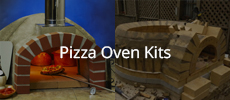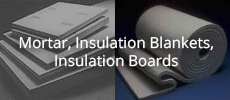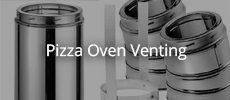The characteristics of the rock wool may vary from different manufacturers, but the stuff I got was too floppy which created problems with getting the vermicrete to stand up vertically against the sides at the base of the dome as well as compression when applying even a really lean vermicrete over the top. The same problem occurs with fibreglass insulation. If the insulation compresses then its capacity to insulate is compromised, apart from the requirement of a vermicrete layer needing a firm substrate on which to apply. In addition to this problem the stuff was hard to cut neatly the way you can with ceramic fibre. You may find a product that does not have these characteristics and will work as well as ceramic fibre blanket, I only offer my experience with using it instead of ceramic fibre blanket for two ovens. If you are not building an igloo and creating a hard outer rendered shell, but building an enclosure then a layer of ceramic fibre blanket followed by rock wool or fibreglass insulation would be a good solution.
The ceramic fibre blanket I use (Superwool) also comes in two different densities 96 or 128 kg/m3. I use the 96, slightly cheaper and a higher rated insulator. It is quite firm enough to build over without compressing.
Announcement
Collapse
No announcement yet.
Casting Refractory - This is NOT a drill!
Collapse
X
-
I used mineral wool for two ovens, but won't use it again. It is quite a bit cheaper than ceramic fibre blanket (by about 25% from memory) and only slightly less insulating, but using and applying it was another story. It doesn't cut nearly as well as CFB, is far fluffier and compresses too easily. Covering it with a layer of vermicrete was also quite problematic. The vermicrete wouldn't stand up vertically against it easily the way it does with CFB. If building a dog kennel design I would consider it, but not for an igloo.[/QUOTE]Originally posted by david s View Post"I would suggest that home owners look into adding Mineral Wool to the list of insulating materials. At our temperatures, the insulating properties are fantastic!! Even when compared to ceramic blanket. I would still put a layer of ceramic fiber (paper or blanket) against the dome as extra insurance for where ever a dome cracks (they all will but not cause any structure issue). But right after that, a good 2 - 3 or 4 inches of mineral wool! That would help keep heat loss through the dome down a lot, keeping more inside the hot-face lining and inside the oven".
I was considering mineral wool layers on top of an initial layer of ceramic fiber blanket, topping with an inch or so of vermicrete. The mineral wool shows better insulation characteristics with lower cost and it doesn't need to be cured like vermicrete. I prefer having the much higher temperature rated ceramic fiber right next to the fire brick. I would use mineral wool be in roll form.
I am wondering if the issues David S (Pizzaiolo) had were due to using bats, which are stiff, rather than roll form material.
Leave a comment:
-
Great knowledge David s... I am getting excited.. I’ll start my own build thread soon
Leave a comment:
-
This reminds me of a very instructive incident some 40 years ago when I was biscuit firing a small wood fired kiln at the same time as teaching classes. Consequently because of the wood firing and not being able to constantly monitor, I was unable to control the temperature rise slowly and the kiln contents had lots of micro cracking, those cracks generally getting worse when the wares were glaze fired. Thereafter I always biscuit fired in an electric kiln.
Leave a comment:
-
To achieve its full strength castable refractory requires sintering. This is the process that converts the chemical bond of the calcium aluminate cement to one which makes the clay content permanent. This process begins at 573C and continues up to around 650C and the material getting harder north of those temps. In the normal situation the material is fired in place with burners in a very controlled manner up to service temperature well over 1000C. If you have access to a kiln, sections or bricks made from castable refractory can be kiln fired and the resulting products are equivalent to firebrick. The use of castable refractory for ovens does not sinter the material, so the bond relies on the chemistry of the calcium aluminate cement. This actually leaves it vulnerable if continually fired up to the 500-650C range where differing expansion rates of the materials contained in the mix make it vulnerable. As this is generally beyond our cooking range, as long as the oven is not fired up too hot it will be fine. It is a mistake to think you can fire it up to sintering temperatures in order to strengthen the material. When firing with wood it is not possible to control the temperature rise in a slow controlled way. The material simply results in micro cracking.
For this reason, because of the vast difference in cost between castable refractory and homebrew, for a one off build the homebrew is a better choice.
Firing an oven quickly can also damage the mortar either homebrew or calcium aluminate based mortars as they have not been sintered either. Much better to take it slow, allow the temperature to rise gently <200C/hr and be kind to your refractory. Unfortunately we always tend to be in a rush to get the temp up as fast as possible.Last edited by david s; 12-16-2020, 02:16 PM.
- Likes 1
Leave a comment:
-
Aloha David S and Utah beaver... thanks for the tips... I have looked at all the Hawaii builds and am using them for reference on material locations... I new something was up with my math.. lol... on edge... looks like away to get you to buy more brick... anyways I feel like I am hijacking enz’s mizzou thread so propabaly should start my own build thread now... ttyl
Leave a comment:
-
If you do a search on "hawaii" you will see several builds and maybe some info on supply sources. You may want to reconsider the use of a yoga ball and do a in place sand mold. I know that this is the preferred method by DavidS for a myriad of reasons. Area of a 41" circle (37" id 2 x 2" cast wall) = 9.2 sq ft each 4" wide by 2.5" thick by 9" long fire brick is 0.25 sq ft (4 x 9)so you need a min of 40 bricks plus a few extra. The 6 per sq foot is assuming laid on the 2.5" edge (not necessary). Mineral wool insulation is not your best dome insulation option, ceramic fiber is best with a p or v crete or possibly a pumice/concrete mix. There have been several good cast ovens done this year. Do a seach on these, Nick's from the UK did a very good job. PS family roots from Oahu and Maui.
Leave a comment:
-
"I would suggest that home owners look into adding Mineral Wool to the list of insulating materials. At our temperatures, the insulating properties are fantastic!! Even when compared to ceramic blanket. I would still put a layer of ceramic fiber (paper or blanket) against the dome as extra insurance for where ever a dome cracks (they all will but not cause any structure issue). But right after that, a good 2 - 3 or 4 inches of mineral wool! That would help keep heat loss through the dome down a lot, keeping more inside the hot-face lining and inside the oven".[/QUOTE]
I used mineral wool for two ovens, but won't use it again. It is quite a bit cheaper than ceramic fibre blanket (by about 25% from memory) and only slightly less insulating, but using and applying it was another story. It doesn't cut nearly as well as CFB, is far fluffier and compresses too easily. Covering it with a layer of vermicrete was also quite problematic. The vermicrete wouldn't stand up vertically against it easily the way it does with CFB. If building a dog kennel design I would consider it, but not for an igloo.Last edited by david s; 12-18-2020, 12:50 PM.
Leave a comment:
-
If you're near the beach you may be able to access some free pumice stone to use as insulating aggregate instead of perlite or vermiculite.
Leave a comment:
-
Thank you David for this advice.... at $5 a fire brick local Honolulu ... I will need about 12 square feet... local web site says 6 bricks for each square foot... so 72 bricks.. ($360 just for the oven floor bricks and I am not even sure of the quality of these fire bricks.. we don’t have many options in Honolulu... maybe I am doing something wrong with the math here.. these are standard clay brick size... 72 bricks for oven floor just don’t seem right... I am using 95 cm yogas ball 37 inch...
as far as the Mizzou I here it’s very expensive... and still waiting for pacific refractory to respond to my call and to get pricing... we do have all the ingredients in Honolulu to make home brew... I will search the forum for more info about using home brew for the dome... I am all in if it works well for absorbing and refracting heat and is cheaper... I am assuming you follow the protocol of insulating with some kind of mineral blanket and a fat layer of perlicrete...
thanks for the quick response David.. I am excited to begin and know my strategy for building this in Hawaii... aloha
Leave a comment:
-
Not a good solution. For the floor you really need dense firebrick. A floor made in castable refractory really needs to be kiln fires. It’s ok for the dome but not for the cooking floor. An alternative to using a proprietary dense castable refractory for the dome is to use the homebrew which is much cheaper. 3:1:1:1 sand, cement, hydrated lime, powdered clay.
Leave a comment:
-
I know this is a very old post but when I search Mizzou Castable this pops up... this build is very close to what I will do... Mizzou sounds like a great expensive product but much better than casting the dome with perlicrete and at the cost of fire brick ($5 a peice) in Hawaii this may be my option... I am looking into pacific refractories in Honolulu who claim to have Mizzou refractory cement.... we will see... in Honolulu we have $5 dollar fire brick and Mizzou refractory... we also have white Portland cement and perlite..
1) question to enz or who over can help...
in this build you use perlicrete over the concrete base... then covered that with the Mizzou refractory cement as your pizza oven floor...
a) is this an acceptable product for food contact application...???
b) how did this mizzou product work out for you as your pizza oven floor???
thank you
Leave a comment:
-
Re: Casting Refractory - This is NOT a drill!
Enz,
I am reading with interest your post on casting your own refractory bricks. I am in desperate need of refractory bricks for a 1956 oven I use. This oven uses cast ceramic elements attached to cast iron air/natural gas premix burners to heat laminating materials. Would you or someone you know consider trying to make these bricks for me. Know this is a strange request, but I am up thee proverbial creek without these bricks. Thanks.
Mike
mike@arvinyl.com
Leave a comment:
-
Re: Casting Refractory - This is NOT a drill!
I referred to a group of castables AP Green had manufactured. These were also referred to as "low cement" castable refractories. Do not let the "low cement" term scare you - these were extremely strong materials! Their impact and abrasion resistance were phenomenal too.
Leave a comment:
-
Re: Casting Refractory - This is NOT a drill!
The fibers are of such a small volume that the porosity they add has an insulating affect approaching zero. The porosity left over from excess water contributes more.
Mizzou Castable is a relatively dense, high alumina castable refractory that has very high strength and can take temperatures far exceeding what we would experience in a normal wood-fired oven. Heck, it would make a great lining for firing pottery and hold up for years.
If there are newer castable refractories out there with densities approaching a dry-pressed fire brick (low, high or super duty) and can withstand @ 2200 F. check them out - they would probably do very well as the hot face material in a wood-fired oven. I recall that AP Green had a series of castables that were referred to as flux vibrating castables that I would love to get my hands on! These were mixed with minimal amounts of water, would appear to be damp (not wet or dry) and would fail the 'ball in hand' test above (the handful would just fall apart and never stay together when properly mixed). The only way to cast anything with them was to use very high frequency vibrators immersed in the castable - and if the vibrator lost power when in the castable you'd rarely be able to get it out. Heck, right after vibrating you could walk on top of it and not sink in. VERY dense. But VERY susceptible to exploding on the first heat up. The material was so dense steam from any excess water had trouble getting out, building up pressure. A very slow initial heatup was required. But it would give you an extremely hard and dense lining. Heat storage capabilities were right there with brick! And the cost was about 1/3 lower than Mizzou Castable.
I would suggest that home owners look into adding Mineral Wool to the list of insulating materials. At our temperatures, the insulating properties are fantastic!! Even when compared to ceramic blanket. I would still put a layer of ceramic fiber (paper or blanket) against the dome as extra insurance for where ever a dome cracks (they all will but not cause any structure issue). But right after that, a good 2 - 3 or 4 inches of mineral wool! That would help keep heat loss through the dome down a lot, keeping more inside the hot-face lining and inside the oven.Last edited by altamont; 06-17-2010, 10:41 AM.
Leave a comment:





Leave a comment: